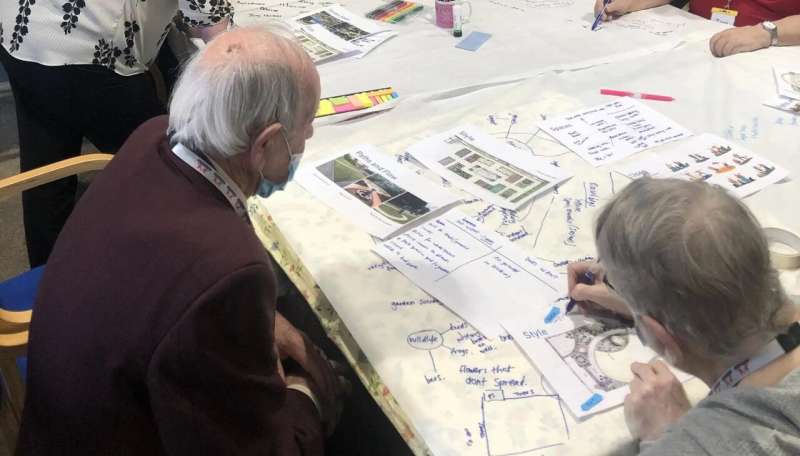This article has been reviewed according to Science X's editorial process and policies. Editors have highlighted the following attributes while ensuring the content's credibility:
fact-checked
trusted source
proofread
People living with dementia can be powerful design collaborators, research shows

People living with dementia should have more power and creative freedom in collaborative design projects, new research from Heriot-Watt University suggests.
This includes using their own ideas and actions to shape, lead and deliver projects, rather than always having projects given to, for or with them.
Dr. Euan Winton, a design expert at the University's School of Textiles and Design in Galashiels in the Scottish Borders, has proposed a new framework that outlines this way of working. It follows six years of working with members of an Alzheimer Scotland Dementia Resource Center who designed projects and services including printed textiles, ceramics, tabletop gardens, lighting, travel postcards, sculptural signage for a community allotment and a photo scanning service.
Collaborative design—shortened to co-design—helps communities and groups contribute to design projects, with guidance from professional designers. It is a growing field in settings including health, community development, innovation, public sector and charities. But there are huge variations in the extent to which participants are involved in these projects, Dr. Winton argues.
His research paper, "The co-design participatory power pyramid," formally defines these different levels of involvement and illustrates them as a pyramid with four layers—"to," "for," "with" and "by." "To" is at the base of the pyramid and "by" is at the top. The study is published in DRS2024: Bilbao.
"Good collaborative design is about helping people play a significant role in rethinking things that inform or shape their lives," Dr. Winton says. "And really that should mean you've collaborated on more than 50% of the project. Your thoughts, your actions, your ideas and the content you generate is important and you should have quite a bit of agency in making changes.
"We see a lot of co-design projects being done to, for or with participants. But the most empowering model is co-design 'by'—when designs for products or services are generated entirely by people living with dementia. It's about reinforcing the idea that people need to be recognized for what they can do, recognized for having rights and that they should be listened to."
Dr. Winton's maternal and paternal grandmothers both had dementia. The mother of research co-author Paul Rodgers, Professor of Design, Manufacturing and Engineering Management at the University of Strathclyde, also had dementia.
Dr. Winton started his research as part of a Ph.D. focused on design for dementia and over six years has worked on collaborative design projects with around 20 members of the Glasgow Dementia Resource Center, which supports people with dementia and is run by Alzheimer Scotland, Scotland's national dementia charity.
The participants were aged between their 40s and 60s and diagnosed with early onset dementia, when symptoms develop before the age of 65. The research included walking tours and visits to museums and art galleries with people living with dementia, to get ideas for designs.
"One of the very first conversations I had was with a man who said he used to quite like photography, but no one would give him a camera these days," Dr. Winton relates. "I replied—that's the first thing I'm going to do when we go out walking. You're all going to have cameras—and will be collecting the images and things that inspire you."
The inclusive approaches, which also involved working with a dementia group in Edinburgh, generated 15 design projects which are outlined in the research paper. Some of the products created were sold in a pop-up shop in Glasgow and the projects overall promoted "self-belief," "free thinking" and a "stronger sense of capability, belonging and independence."
The products and services that were co-designed by people living with dementia include:
- Printed textiles inspired by murals in Glasgow of comedian Billy Connolly. These textiles were turned into products, including cushions, bags and lampshades.
- Ceramic plates with face designs inspired by a 'floating head' exhibit at the Kelvingrove Art Gallery and Museum in Glasgow.
- Tabletop gardens inspired by outdoor walks that the participants design and created themselves.
- A decorative light inspired by Charles Rennie Mackintosh, made with colored lighting gels.
- A concrete sign for Bellahouston Park Allotments in Glasgow that was designed by the participants and then crafted by a stone specialist.
- A photo scanning service to help other people living with dementia revive memories from old photographs.
Dr. Winton said the participants all took enthusiastic ownership of their projects and "regularly expressed elation" with their abilities and a "sense of disbelief" at what they had achieved. They also learned about design practices and took projects in their own direction.
The research paper concludes that people living with dementia should be involved as much as possible in as many stages of the design process as possible. These stages include background research; developing the product design brief based on customer needs; generating ideas and concepts; developing technical drawings and prototypes and then detailed design, incorporating exploration of materials and manufacturing techniques.
Dr. Winton said the co-design participatory power pyramid could be applied to collaborative design projects in any sector. He is bidding for funding to further develop his research and presented his paper in June in Boston to the Design Research Society, a learned society committed to promoting and developing design research.
More information: Winton, E., and Rodgers, P., The co-design participatory power pyramid, DRS2024: Bilbao (2024). DOI: 10.21606/drs.2024.459




















